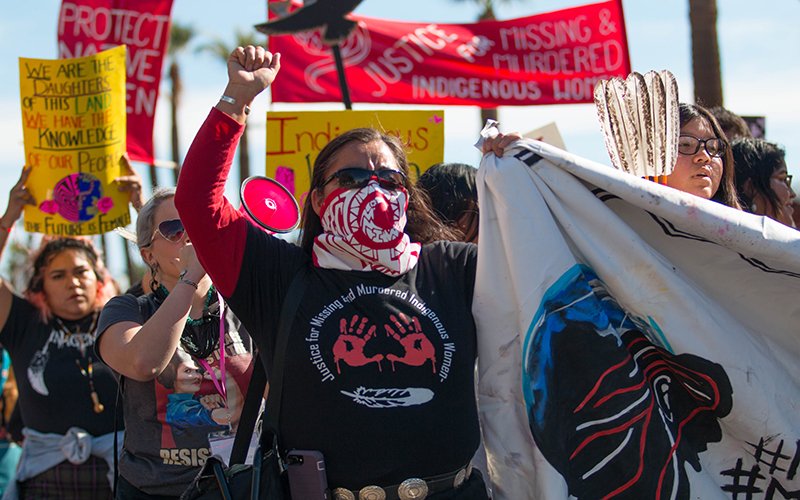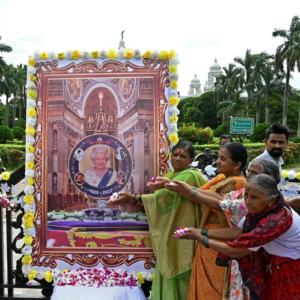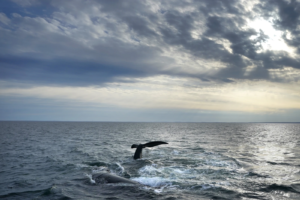Indigenous women face murder rates up to 10 times the national average
May 5 is the National Day of Awareness for Missing and Murdered Indigenous Women and Girls (MMIWG).
In 2017, the U.S. Senate signed a resolution that designated May 5 as the “National Day of Awareness for Missing and Murdered Native Women and Girls.” Sen. Steve Daines, R-Montana, introduced the resolution in response to the disappearance and death of Hanna Harris, a citizen of the Northern Cheyenne Tribe.
Harris was reported missing in Lame Deer, Mont., by her family on July 5, 2013. Her body was found five days later.
“Hanna Harris was determined to have been raped and murdered, and the individuals accused of committing those crimes were convicted,” the resolution states. “The case of Hanna Harris is an example of many similar cases.”
May 5 was designated the National Day of Awareness for Missing and Murdered Indigenous Women and Girls because Harris was born on May 5, 1992.
The resolution calls for people to demonstrate solidarity with the families of victims, as well as to honor the lives of the missing and murdered Indigenous women and girls — both those whose cases are documented and undocumented in public records and the media.
Events are being held at the local, state and national level by advocates and organizations in hopes of allowing people to reflect on the movement and also discuss the work that still needs to be done.
Honwungsi Consulting Services Executive Director Valaura Imus-Nahsonhoya said that, over the last few years, awareness on MMIWG has grown and even evolved as some organizations are starting to advocate for all Indigenous people rather than just women and girls.
Imus-Nahsonhoya said that many people have been providing advocacy surrounding issues related to MMIWG for a long time: Organizing and education on assault, sexual assault, abduction, kidnapping or trafficking are all part of MMIWG.
The MMIWG movement has heightened the response, she said, thanks to the grassroots efforts of Indigenous women.
An upcoming event at the Arizona State Capitol on May 5 is the result of several organizations who came together, Imus-Nahsonhoya said. The event starts with a 5K run and walk from Papago Park to the Capitol, west of downtown Phoenix, where the event will continue with workshops, guest speakers, live entertainment and more.
Imus-Nahsonhoysa, who helped organize the event, said it also gives people a chance to see the networking that goes on between the tribal, state and community-based programs. Attendees will get the opportunity to identify programs within their communities that could help them.
“We want to share these resources. We want to break these barriers,” she said. “We don’t want this to continue generation to generation.”
There will also be space for attendees to come and make signs in honor of their families, survivors, victims and advocates.
“We are doing a lot of work around here to be mindful of our families, survivors and loved ones who have passed on,” Imus-Nahsonhoya said.
An Arizona Mirror analysis of the sparse available data on MMIWG cases found that more than 25% of murders involving Indigenous women in Arizona go unsolved. Additionally, the Murder Accountability Project found that one in three murders of Native Americans in Arizona goes unreported to the FBI.
A 2017 study from the Urban Indian Health Institute found that Arizona has the third-highest number of missing and murdered indigenous women and girls in the country. That study reported a total of 506 known cases in 71 urban cities across the country and 54 cases were identified in Arizona, including 31 in Tucson.
Indivisible Tohono Co-Founder April Ignacio said May 5 is a day of reflection for everyone who has worked to push this movement forward in Arizona. She hopes the event at the Capitol will allow people to come together to do that.
It shows how far they’ve come and how much more work still needs to be done, she said. “Policies need to change (and) laws still need to change.”
“We need to start having these very hard conversations in our community about the future and what we want it to look like,” she added.
Ignacio is a citizen of the Tohono O’odham Nation and has been advocating for MMIWG issues for several years. It started in her community, but eventually she took her work to the federal and state level through Indivisible Tohono.
Indivisible Tohono is a grassroots group that follows current federal and Arizona legislation that primarily impacts the Tohono O’odham Nation.
Ignacio was one of a handful of local Indigenous women who pushed to get Arizona’s Missing and Murdered Indigenous Women Study Committee bill passed in 2019.
She served on the committee until it was repealed in September of last year. Lawmakers had included an extension of the committee in the annual state budget, but that provision was one of dozens that the Arizona Supreme Court said were unconstitutionally slipped into the budget.
Though disappointed that the study committee is now defunct, Ignacio said people have to remember that there are always going to be setbacks in this type of work. But that doesn’t mean there aren’t still a lot of organizations stepping up to do this work.
“Just three years ago, it was a handful of women, and we were really going against the tide,” she said. But their work resulted in the study committee’s creation in the first place.
“It makes me very hopeful for the future,” she said, because many of the people involved in the work surrounding MMIWG do it for the next generation. “It’s about our children growing up without a life of violence.”
In order for that to happen, Ignacio said it comes down to community, and what a healthy community could look like.
To do this, she said that tribal and federal entities need to make sure they’re appropriating the right amount of funding to organizations stepping up to do this type of work.
In some tribal communities, women face murder rates that are more than 10 times the national average, according to the U.S. Department of Justice.
There is no centralized database among the thousands of federal, state and tribal entities in the U.S., but there are a few resources that offer limited data on missing and murdered Indigenous people.
NamUS published a report in August finding that there are 734 unresolved missing Indigenous people’s cases from 36 states. Arizona’s 55 cases were the thirst-most.
And the FBI publishes a roundup every year that highlights the total number of missing persons and unidentified person cases reported.
In 2020, more than 9,500 cases involving Indigenous people were reported, and nearly 1,500 were still active cases at the end of the year.
For murder rates among Indigenous peoples, the Interior Department reported that 2,700 cases of murder and non-negligent homicide offenses have been reported to the federal government’s Uniform Crime Reporting program.
In 2017, homicide was reported as the fourth-leading cause of death among Indigenous women between the ages of 1 and 19 years and the sixth-leading cause of death for ages 20 to 44, according to the Centers for Disease Control and Prevention.
And In a report from the National Institute of Justice, 84% of Indigenous women experience violence in their lifetime, compared to 71% of white women.
On the Navajo Nation, several organizations came together to create a two-day tribunal on May 5 and 6 in honor of MMIWG day.
The Navajo Nation Missing and Murdered Indigenous Women & Relatives Tribunal will be held at the Navajo Nation Museum in Window Rock. It will feature documentaries, panel discussions, public testimonies, talking circles and more.
The goal of the tribunal is to move beyond awareness and present the next steps toward workable solutions.
“What the tribunal means is that we are officially recording all the public testimonies of the victims, families and survivors that attend the conference,” said Charmaine Jackson, director of Ná’áł Kíd Productions, one of the organizers of the event. “The conference is all about the victims, families and survivors. It’s not about talking, it’s about listening.”
Jackson said the tribunal has been in the works since December, and it will focus on the people, families and how they can move forward and work together.
“We’re going to listen to everyone and we’re going to try to learn from each other on how to move forward,” she added.
Jackson said she understands that this type of work and advocacy can be very sad and draining, which is why she commends everyone advocating for the issue.
“It takes a toll on you, physically (and) mentally,” she said. “I want families to come to the event and feel like they’ve made a difference.”
People interested in attending the tribunal need to register for the event. More information can be found on the Navajo Nation MMIW&R Tribunal Facebook page or those interested can email Jackson directly. Space is limited due to COVID-19 restrictions that remain in place on the Navajo Nation.
At the national level, the National Indigenous Women’s Resource Centeralongside the National Partners Work Group on Missing and Murdered Indigenous Women (MMIW) and the MMIW Family Advisors are organizing a National Week of Action from April 29 to May 5.
The week is a call to action for the nation and the world to action in honor of missing and murdered Indigenous women, the website state.
The organization is hosting a week-long of events that include virtual panel discussions, a virtual half marathon and on May 5 a Twitter storm and chat.
The NIWRC has a list of resources available for people to review about MMIW and all of the events during the week are open for registration.
“The current systemic response to violence against Native women is inadequate and the rate at which we are losing our women is devastating to our tribal communities and to the Nation as a whole,” the website states.
Visit the NIWRC website for more information about the events.



